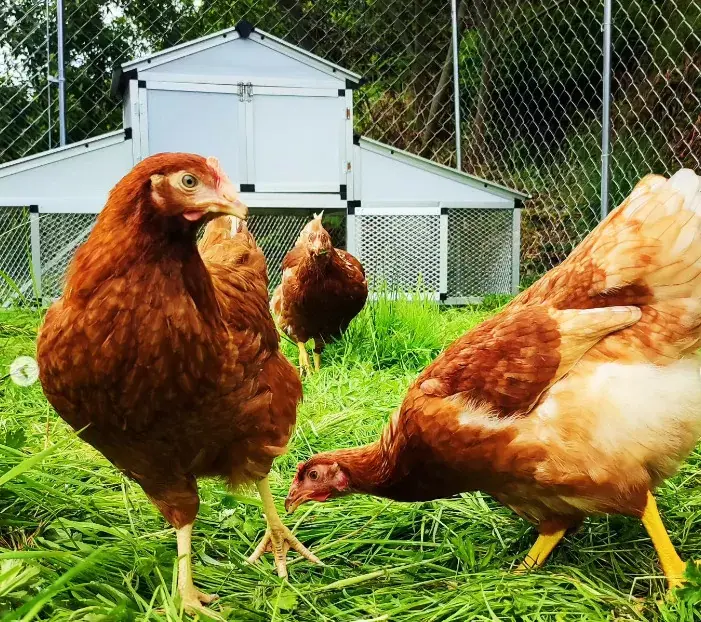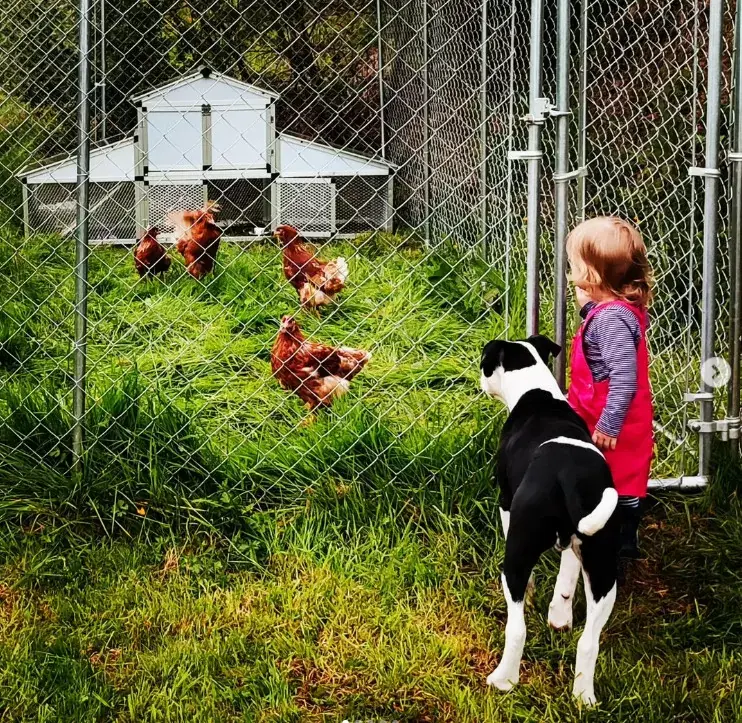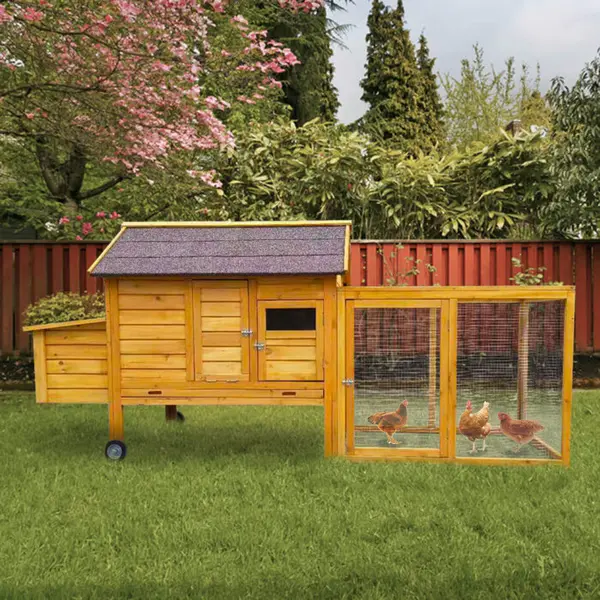How to Choose the Perfect Chicken Coop for Your Irish Backyard
Ah, the grand charm of a verdant Irish backyard, adorned with clucking hens pecking the ground, a sight as comforting as a warm hearth on a chilly evening. If you’re looking to bring this bucolic scene to life in your own garden, the starting point of your journey is choosing the perfect chicken coop.
Once a staple in our grandparent’s homesteads, backyard chicken coops have enjoyed a significant revival across the Emerald Isle in recent years. A delightful blend of self-sufficiency, sustainability, and a yearning for a closer connection with nature has led many of us to return to the charming tradition of raising chickens.
Choosing the right chicken coop in Ireland is not merely a matter of aesthetic preference. It’s akin to picking the right home for your family. A coop needs to offer your feathered friends protection against our whimsical Irish weather, ensure a comfortable space for laying eggs, and provide an environment where they can live healthily and happily.
A well-chosen coop allows the charm of backyard poultry farming to come through, all the while adding to the homely allure of your green patch. In this guide, InTheMarket will explore how to select the perfect chicken coop that suits your needs, fits within your garden, and ensures a hearty life for your feathered brood.
Understanding Your Chickens’ Needs
Before we delve into the particulars of the coop, let’s take a moment to appreciate the stars of the show – your chickens. Each breed has its unique requirements and understanding these will lead you to make an informed coop choice.
Chicken Breed and Their Specific Requirements
Much like us Irish, our feathered friends come with their own idiosyncrasies, habits, and quirks. Some breeds, like the robust Rhode Island Reds, are hardy and known for their ability to withstand our sometimes temperamental Irish climate. Meanwhile, the Orpingtons, with their docile nature and impressive egg-laying abilities, need extra care to keep their luscious plumage in tip-top shape.
Research your chosen breed, understand their behaviour, their space requirements, their egg-laying habits, and their general nature. A coop that complements these characteristics goes a long way in ensuring the well-being of your chickens.
Space Requirements Per Chicken
Space – the eternal conundrum! How much room do chickens need? Well, the answer is, it depends.
As a rule of thumb, each chicken should have a minimum of 2 square feet inside the coop, and 8-10 square feet in an outdoor run. But remember, this is the bare minimum. Just like us humans, chickens appreciate a bit of leg-stretching room, so err on the side of generosity when it comes to allocating space.
Importance of Nest Boxes and Roosting Bars
Ever wondered where your breakfast eggs come from? The answer is nest boxes. For every 4-5 hens, plan for at least one nest box. This is where your hens will feel safe and comfortable to lay their eggs.
Roosting bars, on the other hand, are the chickens’ sleeping quarters. Chickens prefer to sleep off the ground, safe from predators. Ensure your coop has enough roosting space for all your chickens to sleep side-by-side without crowding. Typically, you should allocate about 8-10 inches of roosting bar per chicken.
Remember, a happy chicken is a productive chicken. By catering to these essential needs, you’ll create a thriving environment for your chickens and a step closer to the perfect chicken coop for your Irish backyard.
Choosing the Right Location for Your Chicken Coop

Now that we’ve discussed our clucking companions’ needs, let’s turn our focus to the land beneath our feet. Deciding where to place your chicken coop in your Irish backyard is just as critical as the design of the coop itself.
Factors to Consider: Light, Wind, and Accessibility
Light plays an integral role in the lives of your chickens. They need a good amount of natural light for laying eggs, but also require a darkened place to roost and rest. Ideally, your coop should be positioned to capture the morning sun, while providing shade in the late afternoon.
Winds can be quite nippy in our lovely isle, and while chickens are hardy creatures, they could do without the constant draft. Try to place your coop in a spot that is protected from prevailing winds, but still has good ventilation.
Accessibility is key for maintenance and emergencies. Place your coop close enough to your house so that collecting eggs, feeding, cleaning, and observing your chickens doesn’t feel like a trek. But also remember to be mindful of your neighbours. While you might enjoy the clucking, they may not share your enthusiasm.
Importance of Safe and Secure Location
While Ireland is free of large predators, we do have our share of sly foxes and wily minks. The location of your chicken coop must provide safety and security for your flock. Coops should be sturdy and predator-proof with a fence or a secure run that sinks into the ground to deter any burrowers.
You should also consider flooding risk, especially if you’re located in a lower-lying area. No one likes damp, including your chickens!
Choosing the right location for your chicken coop is a delicate balance of many factors, but with careful consideration, you can find the perfect spot that suits both you and your chickens, making it a seamless and fitting addition to your Irish backyard.
Material and Construction of Chicken Coops
Having identified your chickens’ needs and the perfect location, let’s roll up our sleeves and discuss the physical stuff – the materials and construction of your chicken coop.
Popular Materials Used in Coops and Their Pros and Cons
The most commonly used materials for coops are wood, metal, and plastic. Each has its unique pros and cons.
Wood, with its classic rustic appeal, is the most traditional choice. It offers excellent insulation during our colder Irish months. However, untreated wood can be prone to mites and needs regular maintenance to prevent rot.
Metal coops, typically made from aluminium or steel, are durable, predator-proof, and easy to clean. On the downside, they offer poor insulation and can become excessively hot or cold depending on the weather.
Plastic coops, the newcomer to the scene, are gaining popularity. They are lightweight, easy to clean, and resistant to parasites. However, they can lack the robustness of wooden or metal coops and may degrade over time due to UV exposure.
Essential Features of a Well-Constructed Coop
A well-constructed coop is more than just a shelter. It is a safe haven for your chickens, equipped with all their needs. Here are some essential features to look for:
- Ventilation: A good coop must have proper ventilation to maintain air quality and control temperature and humidity.
- Accessibility: Easy access for cleaning, feeding, and egg collection is crucial. Features like removable roofs, large doors, and pull-out trays can make your life easier.
- Predator-proof: The coop must be sturdy, with locks and reinforced wire mesh to keep out predators.
- Perches and Nesting Boxes: Ensure the coop has adequate space for perches and nesting boxes as per your chickens’ needs.
- Weatherproof: The coop should be able to withstand the varying Irish weather. Waterproof roofs, wind-resistant construction, and proper insulation are key.
Your chicken coop material and construction choice depend on your unique circumstances, including your budget, aesthetic preferences, and the specific needs of your chicken breed. By considering these factors, you’ll ensure your coop is not just a structure but a home for your chickens.
Weather Considerations for Your Coop in Ireland
Ah, the ever-changing Irish weather, with its mixture of sun, rain, wind, and the occasional snow. Your coop needs to stand strong against these varied climatic conditions, providing a safe, comfortable haven for your chickens.
Adapting Your Coop to the Irish Climate
To adapt your coop to the Irish climate, you’ll need to take a few specific steps. During our colder, wetter months, ensure that your coop is watertight and draft-free, yet still well-ventilated. This balance helps keep your chickens warm and dry without the risk of respiratory problems from damp, stagnant air.
During warmer periods, chickens, unlike us, cannot sweat to cool down. Provide shade to protect them from the harsh sun, and ensure that there is adequate ventilation to reduce heat stress.
Remember, Irish weather can sometimes surprise us, even within a single day. Your coop should be robust and versatile enough to withstand these quick changes.
Ventilation, Insulation, and Protection from Elements
Ventilation is a constant requirement, irrespective of the weather. Position vents or windows high up to allow the hot, moist air to escape, but make sure these are covered with predator-proof mesh.
Insulation becomes especially important in the colder months to keep your chickens cosy. Consider materials that naturally provide insulation, like wood, or add insulation to the walls of the coop while ensuring it’s protected from curious pecking beaks.
Protection from elements such as wind, rain, and snow can be achieved through weatherproofing your coop. This can involve using weather-resistant materials, adding a waterproof roof, or even positioning your coop in a naturally sheltered part of your garden.
Weather in Ireland may sometimes feel like a challenge. Still, with these considerations in mind, you can ensure your chicken coop is a cosy, secure retreat for your feathered friends, come rain, shine, or a surprise snow flurry.
Accessibility and Maintenance

In the midst of all our chicken coop planning, let’s not forget about our human convenience. Ensuring the coop is easily accessible and low-maintenance will save you a world of time and energy, leaving more moments to enjoy the delights of backyard chicken keeping.
Importance of Easy Cleaning and Maintenance
Why should we emphasise easy cleaning and maintenance? For one, a clean coop keeps your chickens healthy and your eggs uncontaminated. Secondly, it helps prevent the spread of disease and pests, and finally, it makes your backyard a more pleasant place, free of odours and flies.
Plan for regular cleaning of the coop, including the removal of droppings, old bedding, and uneaten food. With this in mind, look for a coop design that offers easy access to all corners. Features like removable or hinged roofs, large doors, and slide-out trays for droppings can be real time-savers.
For maintenance, consider materials that withstand the Irish weather without constant touch-ups, and designs that provide easy access for any necessary repairs.
Features for Easy Egg Collection and Chicken Care
You’ll be visiting your coop at least once a day for egg collection, feeding, and health checks. Make these tasks more enjoyable with thoughtful coop design.
Include an accessible egg collection box in your coop. A design where you can collect the eggs from outside the coop without disturbing your hens is a winner.
Additionally, easy access to feeders and waterers can make feeding times more efficient. Ensure there’s enough space for you to easily reach in for health checks or to handle your chickens when necessary.
In summary, designing for accessibility and ease of maintenance is crucial in your coop. It not only makes your daily interactions smoother and more enjoyable but also ensures a cleaner, healthier environment for your chickens, leading to happier hens and better eggs for your table.
Ensuring Safety from Predators
Though the Emerald Isle is devoid of large predatory beasts, your flock could still face threats from smaller predators. It’s essential to fortify your chicken coop accordingly, to ensure your feathered friends can rest easy.
Common Predators in Ireland and How to Protect Against Them
The fox, our most common and wily chicken predator, is known for its cunning and persistence. Foxes can dig, climb, and even unhook simple latches.
Mink, while less common, are equally dangerous. Being excellent climbers and swimmers, they can penetrate weak spots in a coop or run with ease.
To protect against these predators, your coop and its run should be a fortress. Use sturdy materials that resist chewing or tearing. If your run is not fully enclosed, bury the fencing at least a foot into the ground to deter digging predators. Likewise, secure the top to keep out any that might attempt to climb or swoop in.
Security Features to Look for in a Chicken Coop
- Sturdy Construction: The coop must be robust and well-constructed, able to withstand attempts to claw, chew or push its way in.
- Secure Locks: Use complex locks that predators can’t easily open. A simple latch may not be enough to deter a determined fox.
- Predator-Proof Wire Mesh: Cover all windows and vents with a strong wire mesh to prevent any intruders.
- Elevated Coop Design: An elevated coop can help protect against some predators and can also keep the coop dry during wet weather.
- Fully Enclosed Run: If your chickens have an outdoor run, ensure it is fully enclosed, including a secure top and buried edges.
Remember, the safety of your chickens is paramount. Ensuring your coop is well-defended against potential predators will give you peace of mind, and your chickens the security they need to thrive. Armed with these tips, you’re ready to create a haven for your hens in your Irish backyard, one that promises safety, comfort, and lots of delightful clucking.
Legal Considerations and Regulations in Ireland
Before you start picturing those fresh eggs for breakfast, it’s vital to consider the legal aspect of keeping chickens in your backyard. Ireland, being the responsible country that we are, has regulations in place to ensure the welfare of animals and public health.
Overview of Local Regulations Concerning Backyard Chickens
In general, keeping chickens in your backyard for personal use is allowed in Ireland. However, some restrictions apply, especially in urban and suburban areas.
Key things to consider include:
- Number of Chickens: Some local authorities limit the number of chickens you can keep. Check your local regulations for specific numbers.
- Roosters: Often, keeping roosters is discouraged or outright prohibited due to the noise they can create.
- Housing and Welfare: Irish law requires that all animals, including chickens, are kept in a manner that ensures their welfare needs are met. This includes access to clean water, suitable food, adequate space, and appropriate healthcare.
- Waste Management: Mismanaged chicken waste can lead to unpleasant smells or attract pests. Proper disposal or composting methods should be in place.
Where to Check for the Latest Guidelines
For the most accurate and up-to-date information, visit the website of your local city or county council. Most local authorities have their animal welfare and livestock regulations available online.
Another resource is the Department of Agriculture, Food, and the Marine’s website, which provides information on national legislation and guidelines.
Don’t forget to also check any rules laid out by your Homeowners Association or landlord if applicable.
Ensuring you are legally compliant is a crucial step in setting up your backyard chicken coop. It not only shows respect for your neighbours and community but also contributes to the overall welfare of your chickens, ensuring they have a safe, healthy, and happy life clucking away in your Irish backyard.
Final Thoughts: Balancing Cost and Quality
As we round off our coop journey, let’s address the elephant in the room – cost. While we all strive for the best for our feathered friends, we need to balance this with our budget. Here are some thoughts on striking that balance without compromising on quality.
Tips for Finding a Balance Between Price and Quality
- Do Your Research: Shop around, both online and in physical stores. Compare prices, materials, and features before you make a decision.
- Think Long-Term: A cheaper coop might save you money now but could cost more in repairs or replacements in the future. Investing a bit more upfront can lead to longer-term savings.
- DIY: If you’re handy with tools, consider building your own coop. You can control the cost, quality, and customise it to your specific needs.
- Size Wisely: Don’t overdo the size of your coop. Keep it sufficient for your flock’s size. A smaller, quality coop is a better investment than a larger, lower quality one.
Benefits of Investing in a High-Quality Chicken Coop
High-quality chicken coops come with multiple benefits:
- Durability: A well-made coop will stand the test of time (and Irish weather), saving you money and effort in the long run.
- Healthier Chickens: High-quality coops provide better protection from predators, weather, and disease, leading to healthier, happier chickens.
- Less Maintenance: Better materials and construction mean less time spent on repairs and adjustments.
- Easier Management: Quality coops often come with user-friendly features, making your chicken-keeping experience more enjoyable.
- Better Resale Value: If you ever decide to upgrade or sell your coop, a well-maintained, high-quality coop will fetch a better price.
In the end, choosing the perfect chicken coop for your Irish backyard is a balance between your chickens’ needs, your budget, and local regulations. With careful planning and thoughtful choices, your chicken coop can become a delightful addition to your home, bringing joy, fresh eggs, and perhaps a hint of the farm life to your everyday urban existence.

